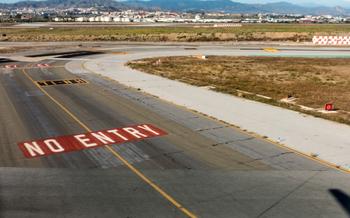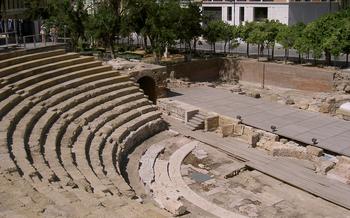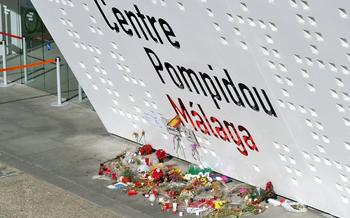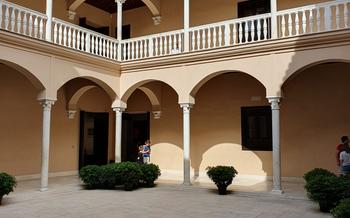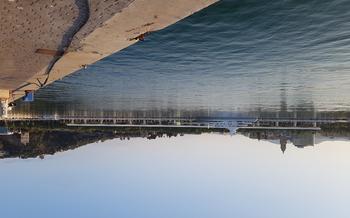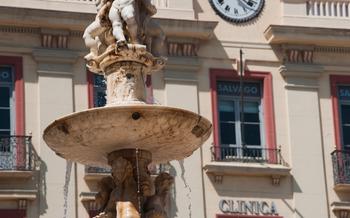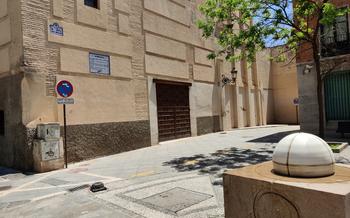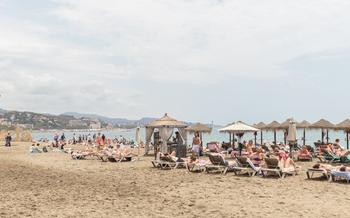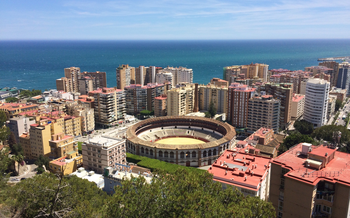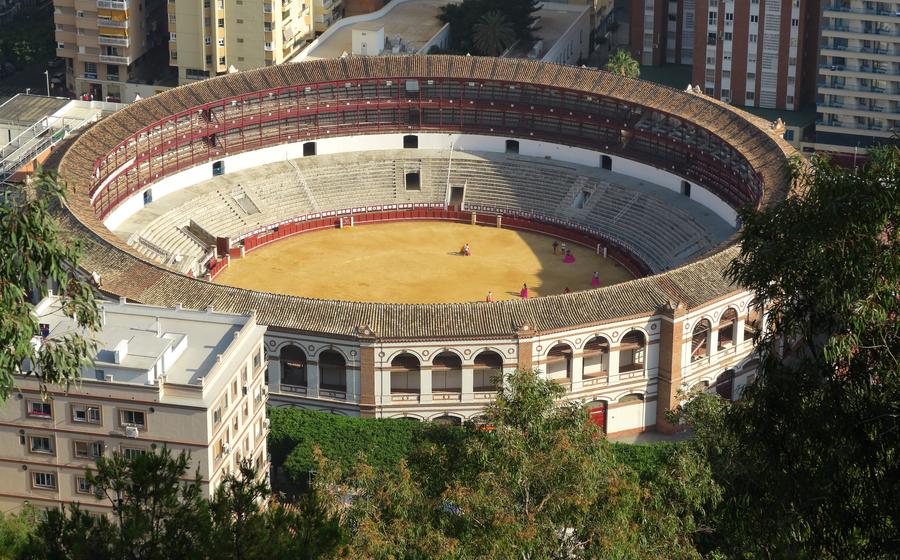
Plaza de toros de La Malagueta
- Plaza de Toros de La Malagueta: A Historical Bullring
- The Bullfighting Museum: A Journey into Taurine Culture
- Exploring the Neighbourhood: Vibrant La Malagueta
- Practical Information: Planning Your Visit
- Famous Bullfighters: Legends of the Ring
- Bulls with a Legacy: Facing the Brave
- A Unique Cultural Experience: Beyond the Spectacle
- Local Perspective: Bullfighting in Malaga
- Alternative Attractions: Exploring Malaga
- Capture the Moment: Photography Tips
- Insider Tip: Hidden Gem of La Malagueta
Plaza de Toros de La Malagueta: A Historical Bullring
A Majestic Symbol of Spanish Heritage
In the vibrant city of Malaga, nestled within the charming neighbourhood of La Malagueta, stands a monumental structure that embodies the essence of Spanish culture – the Plaza de Toros de La Malagueta. This iconic bullring, inaugurated in 1876, has witnessed countless battles between man and beast, becoming a symbol of the deep-rooted tradition of bullfighting in Spain. Its unique design, featuring a striking Neo-Mudéjar architectural style, adds to its allure, making it a captivating landmark that attracts visitors from around the world.
Architectural Grandeur and Cultural Significance
The Plaza de Toros de La Malagueta boasts an impressive architectural design that seamlessly blends traditional Andalusian elements with modern influences. Its circular form, reminiscent of ancient Roman amphitheatres, is accentuated by intricate horseshoe arches and decorative tiles that adorn the exterior. The interior of the bullring is equally captivating, with tiered seating arranged around a central arena, providing spectators with an unobstructed view of the action.
Beyond its architectural significance, the Plaza de Toros de La Malagueta holds immense cultural value. Bullfighting, a controversial yet deeply ingrained tradition in Spain, finds its stage within these historic walls. The spectacle, steeped in symbolism and ritual, showcases the bravery of the matador as they face the might of the bull in a dance of life and death.
Controversy and Cultural Evolution
The tradition of bullfighting has been a subject of intense debate, with strong arguments on both sides. While some view it as a barbaric practice that inflicts unnecessary suffering on animals, others defend it as an integral part of Spanish cultural heritage. The controversy surrounding bullfighting has led to its decline in popularity in recent years, with many regions of Spain opting to ban the practice altogether. However, in Malaga, bullfighting remains a significant cultural event, and the Plaza de Toros de La Malagueta continues to host bullfights during the city's annual feria.
The Bullfighting Museum: A Journey into Taurine Culture
The Plaza de Toros de La Malagueta houses a fascinating museum dedicated to the history and culture of bullfighting in Spain. As you step inside, you'll be transported into a world of tradition, bravery, and controversy.
The museum's exhibits showcase a vast collection of artefacts related to bullfighting, including elaborate costumes worn by matadors, capes used in the ring, and the swords that deliver the final blow. These items offer a glimpse into the lives and rituals of these iconic figures.
Learn about the techniques and traditions of bullfighting through interactive displays and informative panels. Discover the roles of the matador, the picadors, and the banderilleros, each playing a crucial part in the spectacle.
The museum also delves into the controversial aspects of bullfighting, addressing ethical concerns and the ongoing debate surrounding the practice. It presents arguments from both sides, allowing visitors to form their own opinions on this complex issue.
Whether you're a fan of bullfighting or simply curious about its cultural significance, the Bullfighting Museum offers a comprehensive and thought-provoking journey into the world of taurine culture.
Exploring the Neighbourhood: Vibrant La Malagueta
Beyond the Plaza de Toros, the surrounding neighbourhood of La Malagueta exudes charm and authenticity. Stroll through its narrow streets lined with traditional Andalusian architecture, characterized by whitewashed buildings adorned with colourful tiles and intricate iron balconies. Discover hidden plazas, where locals gather to socialize, and soak in the lively atmosphere of this vibrant district.
La Malagueta is a culinary haven, offering a plethora of restaurants serving delectable local cuisine and traditional tapas. Indulge in mouthwatering dishes such as "pescaíto frito" (fried fish), "espetos de sardinas" (grilled sardines), and the famous "ajoblanco" (cold garlic soup). Pair your meal with a glass of refreshing local wine or savour a cold beer at one of the many charming bars and cafes that dot the neighbourhood.
When the sun sets, La Malagueta transforms into a vibrant hub of activity. Lively bars and cafes spill out onto the streets, creating a festive atmosphere that invites you to join in the merriment. Experience the infectious energy of flamenco music, often performed live, and let the rhythm carry you away as you savour the moment.
The proximity to the beach adds to the allure of La Malagueta. Take a leisurely stroll along the picturesque promenade, enjoying the gentle sea breeze and stunning views of the Mediterranean Sea. Relax on the sandy beaches, bask in the warm sunshine, and dip your toes in the refreshing waters.
La Malagueta seamlessly blends history, culture, and vibrant local life. Whether you seek culinary delights, lively entertainment, or simply a relaxing day by the beach, this charming neighbourhood offers an unforgettable experience that will leave you longing for more.
Practical Information: Planning Your Visit
Visiting the Plaza de Toros de La Malagueta and the Bullfighting Museum requires some practical considerations to ensure a smooth and enjoyable experience. Here's a guide to help you plan your visit:
- Operating Hours and Ticket Prices:
- The Plaza de Toros is typically open for guided tours daily, with varying hours depending on the time of year. Check the official website or contact the bullring directly for exact timings.
-
Guided tours of the bullring and the museum are available, with ticket prices varying depending on the package and any special exhibitions or events. Discounts may be offered for students, seniors, or groups.
-
Dress Code and Attire:
-
If you plan to attend a bullfight, appropriate attire is recommended. Smart casual or formal dress is customary, with men often wearing suits or smart trousers and women opting for dresses or smart separates. Avoid shorts, flip-flops, or overly casual clothing.
-
Accessibility Options:
-
The Plaza de Toros is wheelchair accessible, with ramps and elevators provided for easy movement throughout the bullring. Accessible seating is also available for visitors with disabilities.
-
Finding the Best Seats:
- When attending a bullfight, choosing the right seats can enhance your experience. The "tendidos," or lower rows of seats closest to the ring, offer an immersive perspective of the action. The "gradas," or upper rows, provide a broader view of the bullring and the crowd.
Famous Bullfighters: Legends of the Ring
The world of bullfighting has produced legendary figures who have captivated audiences with their skill, bravery, and charisma. Among the most renowned matadors is Manuel Benítez "El Cordobés," a Spanish bullfighter who revolutionized the art of bullfighting in the 1960s. With his innovative techniques and daring performances, El Cordobés became a national icon and a symbol of the golden age of bullfighting. His rivalry with other great matadors, such as Antonio Ordóñez and Luis Miguel Dominguín, created unforgettable moments in the history of bullfighting. These legendary figures left an indelible mark on the world of bullfighting, inspiring future generations of matadors and contributing to the cultural heritage of Spain. Their names and legacies continue to resonate in the hearts of bullfighting enthusiasts around the world.
Bulls with a Legacy: Facing the Brave
Throughout the history of bullfighting, certain bulls have distinguished themselves, leaving an indelible mark on the spectacle. These legendary bulls are remembered for their bravery, ferocity, and the unforgettable encounters they had with matadors.
One such bull was Miura, a legendary bull from the Miura Ranch, known for its aggressive and unpredictable behaviour. Miura faced some of the most renowned matadors of his time, including Juan Belmonte and Manuel Rodríguez "Manolete." His performances in the ring were characterized by his strength, agility, and unwavering spirit, making him a formidable opponent for even the most experienced matadors.
Another notable bull was Islero, who gained fame for his encounter with the legendary matador Manolete in 194Islero fatally gored Manolete during a bullfight in Linares, Jaén, marking a tragic end to the career of one of the most celebrated bullfighters in history. Islero's name became synonymous with danger and bravery, forever etched in the annals of bullfighting history.
These legendary bulls are not only remembered for their ferocity but also for their unique characteristics and fighting styles. Some bulls, like Cagancho, were known for their intelligence and cunning, while others, like Bambi, were renowned for their speed and agility.
Stories of bravery and close encounters with matadors abound when it comes to these legendary bulls. "El Cordobés" famously faced a bull named "Manolete" in a heart-stopping encounter where the matador narrowly escaped serious injury. The bull's ferocity and the matador's skill captivated the audience, leaving an unforgettable impression on all who witnessed the spectacle.
In recent years, there have been controversial cases of bulls that were pardoned and spared from death in the ring due to their exceptional bravery or unique characteristics. These bulls, like "El Juli" and "Almansor", became symbols of animal welfare and sparked debates about the ethical implications of bullfighting.
These legendary bulls represent the essence of bullfighting, showcasing the bravery, strength, and unpredictability of these magnificent animals. Their stories continue to be told and retold, capturing the imagination of bullfighting aficionados and casual observers alike.
A Unique Cultural Experience: Beyond the Spectacle
Bullfighting, despite its controversial nature, holds a significant place in Spanish culture and identity. It is deeply intertwined with Spanish history, traditions, and art. The spectacle of bullfighting goes beyond the physical confrontation between man and beast; it is a representation of Spanish cultural heritage and a symbol of national pride.
The bullfight is a highly ritualized event, steeped in symbolism and tradition. The matador, dressed in his elaborate costume, represents the heroic figure who faces the powerful and dangerous bull. The bull, on the other hand, symbolizes the untamed forces of nature and the wild spirit of Spain.
The spectacle of bullfighting can be captivating, even for those who may not agree with the practice. The skill and courage of the matador, the grace and power of the bull, and the drama of the fight create a unique and unforgettable experience.
Bullfighting has also played a significant role in Spanish literature, art, and cinema. Many renowned writers, such as Ernest Hemingway and Federico García Lorca, have written about bullfighting, capturing its essence and exploring its cultural significance. Artists like Pablo Picasso and Salvador Dalí have depicted bullfighting scenes in their paintings, expressing their fascination with the spectacle and its symbolism.
In essence, bullfighting is not just a sport or a form of entertainment; it is a complex cultural phenomenon that reflects the history, identity, and traditions of Spain. Whether one agrees with it or not, it remains an integral part of Spanish culture and continues to captivate audiences worldwide.
Local Perspective: Bullfighting in Malaga
The city of Malaga has a deep-rooted connection to bullfighting, a tradition that holds significant cultural and historical importance for the local community. The Plaza de Toros de La Malagueta has been a focal point for bullfighting in the city since its inauguration in 1876, attracting renowned matadors and hosting legendary bullfights.
Famous bullfighters from Malaga, such as Manuel Benítez "El Cordobés," have left an indelible mark on the world of bullfighting. "El Cordobés" is particularly revered in Malaga, where his daring style and charisma made him a local hero. His triumphs in the bullring brought international recognition to Malaga and solidified the city's reputation as a hub for bullfighting.
Beyond the spectacle of the bullfight, bullfighting traditions in Malaga are intertwined with local customs and rituals. The "Feria de Agosto," Malaga's annual summer fair, features bullfights as a central attraction, attracting visitors from across the region. During the fair, the streets of Malaga are adorned with festive decorations, and the atmosphere is filled with excitement and anticipation for the upcoming bullfights.
The bullfighting tradition also has a significant impact on Malaga's economy and tourism industry. The city's bullring is a major tourist attraction, drawing visitors eager to experience the spectacle of bullfighting and learn about its cultural significance. The influx of tourists during bullfighting events generates revenue for local businesses, including hotels, restaurants, and souvenir shops.
Alternative Attractions: Exploring Malaga
Beyond the Plaza de Toros de La Malagueta, Malaga offers a wealth of diverse attractions for visitors to explore. Within easy walking distance of the bullring, you'll find the Museo Picasso Málaga, showcasing the works of the renowned artist Pablo Picasso, a native of Malaga. The Alcazaba, a well-preserved Moorish fortress, and the Castillo de Gibralfaro, a hilltop castle with panoramic city views, offer a glimpse into Malaga's rich history.
For those seeking relaxation, the beautiful Malagueta Beach is just a short stroll away, inviting you to bask in the warm Mediterranean sun and enjoy a refreshing swim. The vibrant Muelle Uno, a modern port area, offers a lively atmosphere with its restaurants, shops, and entertainment venues.
Art enthusiasts will delight in the Museo Carmen Thyssen Málaga, which houses an impressive collection of 19th-century Spanish paintings, while the Centro de Arte Contemporáneo de Málaga (CAC Málaga) showcases contemporary art exhibitions.
To experience Malaga's vibrant nightlife, head to the Soho district, known for its trendy bars, clubs, and live music venues. The Calle Larios, a charming pedestrianized street, offers a lively atmosphere with its shops, restaurants, and street performers.
With its diverse offerings, Malaga caters to every traveller's interests, ensuring a memorable and enriching experience beyond the Plaza de Toros de La Malagueta.
Capture the Moment: Photography Tips
The Plaza de Toros de La Malagueta and the surrounding neighborhood of La Malagueta offer a wealth of photographic opportunities. Here are some tips for capturing stunning images:
-
Choose the right time of day: The best lighting conditions for photography are early morning or late afternoon, when the sun is lower in the sky and creates softer, more diffused light.
-
Find the best angles: Experiment with different angles to find the most flattering perspective. For example, shooting from below can make the bullring look more imposing, while shooting from above can provide a panoramic view of the city.
-
Capture the action: If you're attending a bullfight, be ready to capture the fast-paced action. Use a fast shutter speed to freeze the motion and capture the drama of the fight.
-
Don't forget the details: In addition to capturing the overall spectacle, take some time to focus on the details, such as the intricate carvings on the bullring's facade or the colorful costumes of the matadors.
-
Be respectful: When photographing a bullfight, be respectful of the participants and the audience. Avoid using flash photography, which can be distracting and disruptive.
Insider Tip: Hidden Gem of La Malagueta
Beyond the Plaza de Toros and the bustling streets of La Malagueta, there lies a hidden gem waiting to be discovered. Nestled in the heart of the neighbourhood, away from the crowds, is a charming little square called Plaza de San Pedro Alcántara. This picturesque square exudes an old-world charm, with its cobblestone streets, colourful buildings, and a beautiful fountain as its centerpiece.
Take a break from the bullfighting scene and immerse yourself in the peaceful ambiance of Plaza de San Pedro Alcántara. Admire the intricate details of the surrounding architecture, adorned with intricate wrought-iron balconies and flower-filled window boxes. Find a seat at one of the outdoor cafes and savour a cup of coffee or a glass of wine while watching the world go by.
As you relax in this tranquil setting, you'll feel transported back in time. The square comes alive in the evenings, when locals gather to socialize and enjoy the cool breeze. Take advantage of this opportunity to mingle with the locals and learn about their culture and way of life.
Plaza de San Pedro Alcántara is a hidden gem that offers a glimpse into the authentic side of La Malagueta. It's the perfect place to escape the tourist crowds and experience the true essence of this vibrant neighbourhood.
